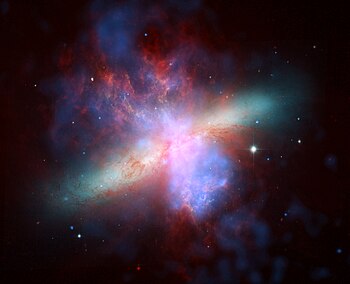Portal:Stars
IntroductionA star is a luminous spheroid of plasma held together by self-gravity. The nearest star to Earth is the Sun. Many other stars are visible to the naked eye at night; their immense distances from Earth make them appear as fixed points of light. The most prominent stars have been categorised into constellations and asterisms, and many of the brightest stars have proper names. Astronomers have assembled star catalogues that identify the known stars and provide standardized stellar designations. The observable universe contains an estimated 1022 to 1024 stars. Only about 4,000 of these stars are visible to the naked eye—all within the Milky Way galaxy. A star's life begins with the gravitational collapse of a gaseous nebula of material largely comprising hydrogen, helium, and trace heavier elements. Its total mass mainly determines its evolution and eventual fate. A star shines for most of its active life due to the thermonuclear fusion of hydrogen into helium in its core. This process releases energy that traverses the star's interior and radiates into outer space. At the end of a star's lifetime as a fusor, its core becomes a stellar remnant: a white dwarf, a neutron star, or—if it is sufficiently massive—a black hole. Stellar nucleosynthesis in stars or their remnants creates almost all naturally occurring chemical elements heavier than lithium. Stellar mass loss or supernova explosions return chemically enriched material to the interstellar medium. These elements are then recycled into new stars. Astronomers can determine stellar properties—including mass, age, metallicity (chemical composition), variability, distance, and motion through space—by carrying out observations of a star's apparent brightness, spectrum, and changes in its position in the sky over time. Stars can form orbital systems with other astronomical objects, as in planetary systems and star systems with two or more stars. When two such stars orbit closely, their gravitational interaction can significantly impact their evolution. Stars can form part of a much larger gravitationally bound structure, such as a star cluster or a galaxy. (Full article...) Selected star - Photo credit: NASA
Canopus (/kəˈnoʊpəs/; α Car, α Carinae, Alpha Carinae) is the brightest star in the southern constellation of Carina, and the second brightest star in the night-time sky, after Sirius. Canopus's visual magnitude is −0.72, and it has an absolute magnitude of −5.65. Canopus is a supergiant of spectral type F. Canopus is essentially white when seen with the naked eye (although F-type stars are sometimes listed as "yellowish-white"). It is located in the far southern sky, at a declination of −52° 42' (2000) and a right ascension of 06h24.0m. Its name comes from the mythological Canopus, who was a navigator for Menelaus, king of Sparta. Canopus is the most intrinsically bright star within approximately 700 light years, and it has been the brightest star in Earth's sky during three different epochs over the past four million years. Other stars appear brighter only during relatively temporary periods, during which they are passing the Solar System at a much closer distance than Canopus. About 90,000 years ago, Sirius moved close enough that it became brighter than Canopus, and that will remain the case for another 210,000 years. But in 480,000 years, Canopus will once again be the brightest, and will remain so for a period of about 510,000 years. Selected article - Photo credit: NASA/ESA
A binary star is a star system consisting of two stars orbiting around their common center of mass. The brighter star is called the primary and the other is its companion star, comes, or secondary. Research between the early 19th century and today suggests that many stars are part of either binary star systems or star systems with more than two stars, called multiple star systems. The term double star may be used synonymously with binary star, but more generally, a double star may be either a binary star or an optical double star which consists of two stars with no physical connection but which appear close together in the sky as seen from the Earth. A double star may be determined to be optical if its components have sufficiently different proper motions or radial velocities, or if parallax measurements reveal its two components to be at sufficiently different distances from the Earth. Most known double stars have not yet been determined to be either bound binary star systems or optical doubles. Binary star systems are very important in astrophysics because calculations of their orbits allow the masses of their component stars to be directly determined, which in turn allows other stellar parameters, such as radius and density, to be indirectly estimated. This also determines an empirical mass-luminosity relationship (MLR) from which the masses of single stars can be estimated. Binary stars are often detected optically, in which case they are called visual binaries. Many visual binaries have long orbital periods of several centuries or millennia and therefore have orbits which are uncertain or poorly known. They may also be detected by indirect techniques, such as spectroscopy (spectroscopic binaries) or astrometry (astrometric binaries). If a binary star happens to orbit in a plane along our line of sight, its components will eclipse and transit each other; these pairs are called eclipsing binaries, or, as they are detected by their changes in brightness during eclipses and transits, photometric binaries. If components in binary star systems are close enough they can gravitationally distort their mutual outer stellar atmospheres. In some cases, these close binary systems can exchange mass, which may bring their evolution to stages that single stars cannot attain. Examples of binaries are Sirius and Cygnus X-1 (of which one member is probably a black hole). Binary stars are also common as the nuclei of many planetary nebulae, and are the progenitors of both novae and type Ia supernovae. Selected image - Photo credit: NASA
Messier 82 (also known as NGC 3034, Cigar Galaxy or M82) is the prototypenearby starburst galaxy about 12 million light-years away in the constellation Ursa Major. The starburst galaxy is five times as bright as the whole Milky Way and one hundred times as bright as our galaxy's center. M82 was previously believed to be an irregular galaxy. However, in 2005, two symmetric spiral arms were discovered in the near-infrared (NIR) images of M82, and is now considered a spiral galaxy. Did you know?
SubcategoriesTo display all subcategories click on the ►
Selected biography - Photo credit: State Post Bureau of the People's Republic of China
Zhang Heng (simplified Chinese: 张衡; traditional Chinese: 張衡; pinyin: Zhāng Héng; Wade–Giles: Chang Heng) (CE 78–139) was a Chinese astronomer, mathematician, inventor, geographer, cartographer, artist, poet, statesman and literary scholar from Nanyang, Henan. He lived during the Eastern Han Dynasty (CE 25–220) of China. He was educated in the capital cities of Luoyang and Chang'an, and began his career as a minor civil servant in Nanyang. Eventually, he became Chief Astronomer, Prefect of the Majors for Official Carriages, and then Palace Attendant at the imperial court. His uncompromising stances on certain historical and calendrical issues led to Zhang being considered a controversial figure, which prevented him from becoming an official court historian. His political rivalry with the palace eunuchs during the reign of Emperor Shun (r. 125–144) led to his decision to retire from the central court to serve as an administrator of Hejian, in Hebei. He returned home to Nanyang for a short time, before being recalled to serve in the capital once more in 138. He died there a year later, in 139. Zhang applied his extensive knowledge of mechanics and gears in several of his inventions. He invented the world's first water-powered armillary sphere, to represent astronomical observation; improved the inflow water clock by adding another tank; and invented the world's first seismometer, which discerned the cardinal direction of an earthquake 500 km (310 mi) away. Furthermore, he improved previous Chinese calculations of the formula for pi. In addition to documenting about 2,500 stars in his extensive star catalogue, Zhang also posited theories about the Moon and its relationship to the Sun; specifically, he discussed the Moon's sphericity, its illumination by reflecting sunlight on one side and remaining dark on the other, and the nature of solar and lunar eclipses. His fu (rhapsody) and shi poetry were renowned and commented on by later Chinese writers. Zhang received many posthumous honors for his scholarship and ingenuity, and is considered a polymath by some scholars. Some modern scholars have also compared his work in astronomy to that of Ptolemy (CE 86–161).
Topics |


